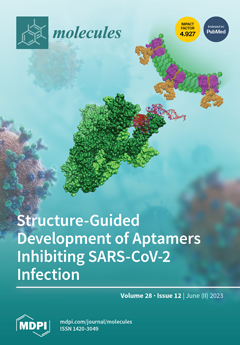Pyrimidines play an important role in modern medical fields. They have a wide spectrum of biological activities such as antimicrobial, anticancer, anti-allergic, anti-leishmanial, antioxidant agents and others. Moreover, in recent years, 3,4-dihydropyrimidin-2(1H)ones have attracted researchers to synthesize them via Biginelli reaction and evaluate
[...] Read more.
Pyrimidines play an important role in modern medical fields. They have a wide spectrum of biological activities such as antimicrobial, anticancer, anti-allergic, anti-leishmanial, antioxidant agents and others. Moreover, in recent years, 3,4-dihydropyrimidin-2(1H)ones have attracted researchers to synthesize them via Biginelli reaction and evaluate their antihypertensive activities as bioisosters of Nifedipine, which is a famous calcium channel blocker. Our new target compounds were prepared through one-pot reaction of thiourea
1, ethyl acetoacetate
2 and/or 1H-indole-2-carbaldehyde, 2-chloroquinoline-3-carbaldehyde, 1,3-diphenyl-1H-pyrazole-4-carbaldehyde,
3a–
c in acid medium (HCl) yielding pyrimidines
4a–
c, which in turn were hydrolyzed to carboxylic acid derivatives
5a–
c which were chlorinated by SOCl
2 to give acyl chlorides
6a–
c. Finally, the latter were reacted with some selected aromatic amines, namely, aniline, p-toluidine and p-nitroaniline, producing amides
7a–
c, 8a–
c, and
9a–
c. The purity of the prepared compounds was examined via TLC monitoring, and structures were confirmed by different spectroscopic techniques such as IR,
1HNMR,
13CNMR, and mass spectroscopy. The in vivo evaluation of the antihypertensive activity revealed that compounds
4c, 7a, 7c, 8c, 9b and
9c had comparable antihypertensive properties with Nifedipine. On the other hand, the in vitro calcium channel blocking activity was evaluated by IC
50 measurement and results revealed that compounds
4c, 7a, 7b, 7c, 8c, 9a, 9b, and
9c had comparable calcium channel blocking activity with the reference Nifedipine. Based on the aforementioned biological results, we selected compounds
8c and
9c to be docked onto Ryanodine and dihydropyridine receptors. Furthermore, we developed a structure–activity relationship. The designed compounds in this study show promising activity profiles in reducing blood pressure and as calcium channel blockers, and could be considered as new potential antihypertensive and/or antianginal agents.
Full article






